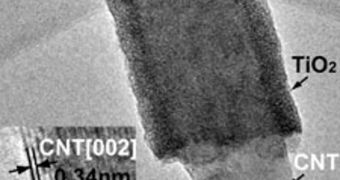Scientists in Germany and China have recently set forth a new hypothesis, saying that using a special type of carbon nanocables in battery construction could help increase these devices' efficiency and capacity considerably. They add that titanium dioxide (TiO2)-coated carbon nanotubes (CNT) have proven to be very apt at this task in laboratory tests, and argue that more research efforts should be focused on the amazing possibilities these materials open up, Chemistry World reports.
At this point, lithium-ion batteries are the most widely used type of energy-storage devices. Experts have found applications for them in everything from mobile phones and laptops to electric cars, but these devices are plagued by several drawbacks, as well as some constraints. As an example, for electric vehicles, these batteries need to be environmentally friendly, light and also hold enormous amounts of power, to allow for extensive driving ranges. The price is also a major factor, so we have only seen moderate progress in this area up to this point.
In lithium-ion batteries, the ions are held in an anode usually made of graphite. As the charged atoms migrate to the cathode, they release electrons, which power up the circuits the battery is connected to. But there are several things wrong, or incomplete, with this approach. The most important is the fact that graphite can hold relatively low amounts of ions, which keep the life time of the batteries below a certain threshold. Therefore, replacing this material is one of the main goals in battery research today. However, previous investigations into CNT and titanium dioxide have proven unsuccessful.
This is owed largely to the fact that these materials cannot release ions as fast as required, though they do store massive amounts of them. “Although it can hold lithium ions effectively, they are slow to diffuse through the structure – and it can take years to fill a millimeter-thick crystal. However, if the TiO2 is only 10nm thick, it is filled in milliseconds. Titanium dioxide on its own is totally unsuitable for electrodes,” research collaborator Joachim Maier, an expert at the Max Planck Institute for Solid State Research, in Stuttgart, Germany, says.
Together with experts from the Beijing National Laboratory for Molecular Sciences, in China, Maier worked on incorporating CNT in the mix, and the end-result is a crystalline solid. It incorporates coaxial carbon nanotubes, coated with porous titanium oxide. The tubes themselves are especially apt at transporting the lithium ions, so hopes are high that this innovation could be vastly improved upon in upcoming researches.

 14 DAY TRIAL //
14 DAY TRIAL //